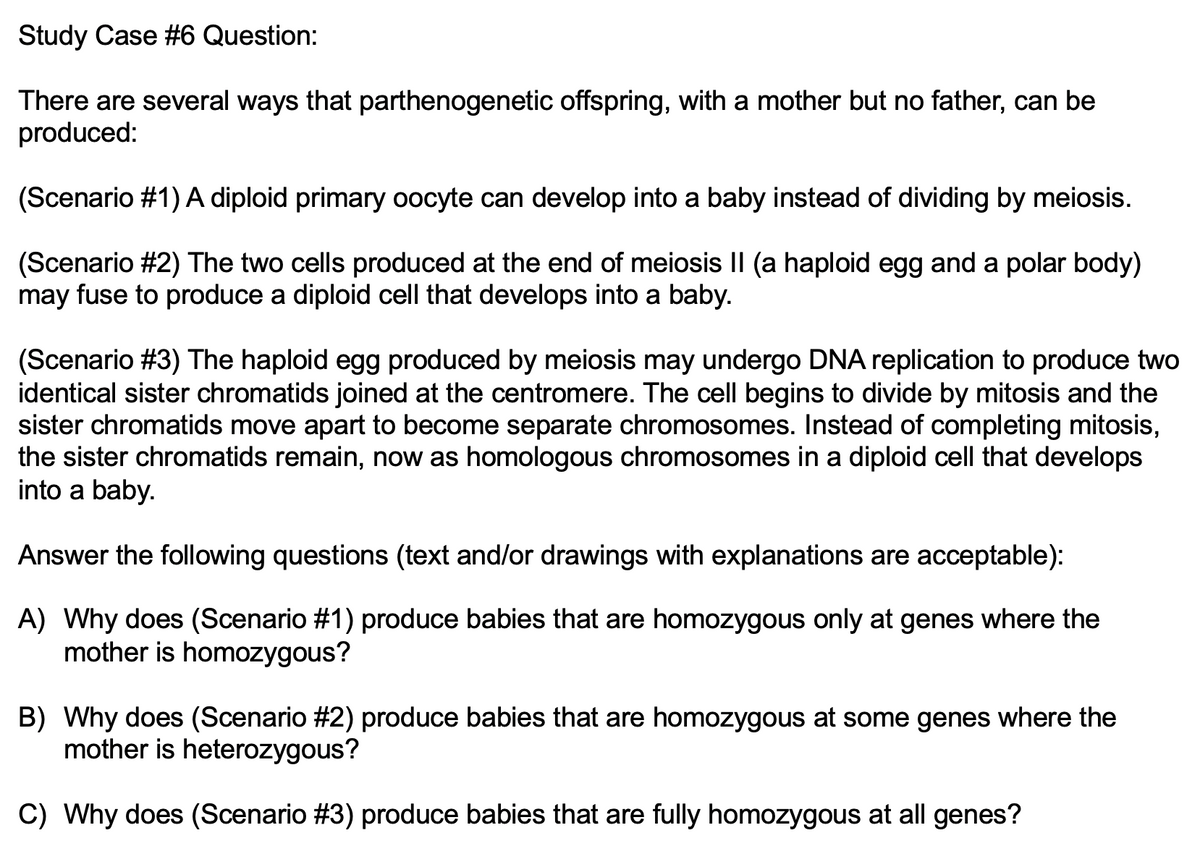There are several ways that parthenogenetic offspring, with a mother but no father, can be produced: (Scenario #1) A diploid primary oocyte can develop into a baby instead of dividing by meiosis. (Scenario #2) The two cells produced at the end of meiosis II (a haploid egg and a polar body) may fuse to produce a diploid cell that develops into a baby. (Scenario #3) The haploid egg produced by meiosis may undergo DNA replication to produce two identical sister chromatids joined at the centromere. The cell begins to divide by mitosis and the sister chromatids move apart to become separate chromosomes. Instead of completing mitosis, the sister chromatids remain, now as homologous chromosomes in a diploid cell that develops into a baby. Answer the following questions (text and/or drawings with explanations are acceptable):
There are several ways that parthenogenetic offspring, with a mother but no father, can be produced: (Scenario #1) A diploid primary oocyte can develop into a baby instead of dividing by meiosis. (Scenario #2) The two cells produced at the end of meiosis II (a haploid egg and a polar body) may fuse to produce a diploid cell that develops into a baby. (Scenario #3) The haploid egg produced by meiosis may undergo DNA replication to produce two identical sister chromatids joined at the centromere. The cell begins to divide by mitosis and the sister chromatids move apart to become separate chromosomes. Instead of completing mitosis, the sister chromatids remain, now as homologous chromosomes in a diploid cell that develops into a baby. Answer the following questions (text and/or drawings with explanations are acceptable):
Biology Today and Tomorrow without Physiology (MindTap Course List)
5th Edition
ISBN:9781305117396
Author:Cecie Starr, Christine Evers, Lisa Starr
Publisher:Cecie Starr, Christine Evers, Lisa Starr
Chapter8: How Cells Reproduce
Section: Chapter Questions
Problem 2.1DID
Related questions
Question
can anyone help

Transcribed Image Text:Study Case #6 Question:
There are several ways that parthenogenetic offspring, with a mother but no father, can be
produced:
(Scenario #1) A diploid primary oocyte can develop into a baby instead of dividing by meiosis.
(Scenario #2) The two cells produced at the end of meiosis II (a haploid egg and a polar body)
may fuse to produce a diploid cell that develops into a baby.
(Scenario #3) The haploid egg produced by meiosis may undergo DNA replication to produce two
identical sister chromatids joined at the centromere. The cell begins to divide by mitosis and the
sister chromatids move apart to become separate chromosomes. Instead of completing mitosis,
the sister chromatids remain, now as homologous chromosomes in a diploid cell that develops
into a baby.
Answer the following questions (text and/or drawings with explanations are acceptable):
A) Why does (Scenario #1) produce babies that are homozygous only at genes where the
mother is homozygous?
B) Why does (Scenario #2) produce babies that are homozygous at some genes where the
mother is heterozygous?
C) Why does (Scenario #3) produce babies that are fully homozygous at all genes?
Expert Solution
This question has been solved!
Explore an expertly crafted, step-by-step solution for a thorough understanding of key concepts.
This is a popular solution!
Trending now
This is a popular solution!
Step by step
Solved in 2 steps

Knowledge Booster
Learn more about
Need a deep-dive on the concept behind this application? Look no further. Learn more about this topic, biology and related others by exploring similar questions and additional content below.Recommended textbooks for you

Biology Today and Tomorrow without Physiology (Mi…
Biology
ISBN:
9781305117396
Author:
Cecie Starr, Christine Evers, Lisa Starr
Publisher:
Cengage Learning

Human Heredity: Principles and Issues (MindTap Co…
Biology
ISBN:
9781305251052
Author:
Michael Cummings
Publisher:
Cengage Learning

Biology Today and Tomorrow without Physiology (Mi…
Biology
ISBN:
9781305117396
Author:
Cecie Starr, Christine Evers, Lisa Starr
Publisher:
Cengage Learning

Human Heredity: Principles and Issues (MindTap Co…
Biology
ISBN:
9781305251052
Author:
Michael Cummings
Publisher:
Cengage Learning